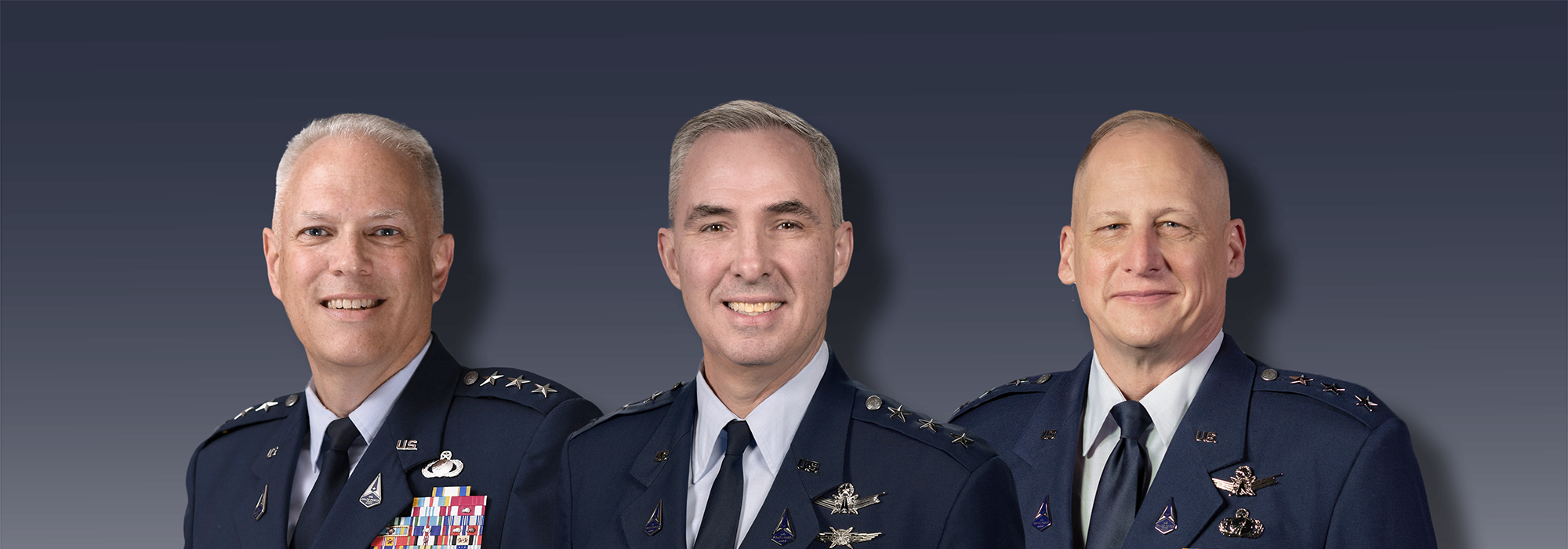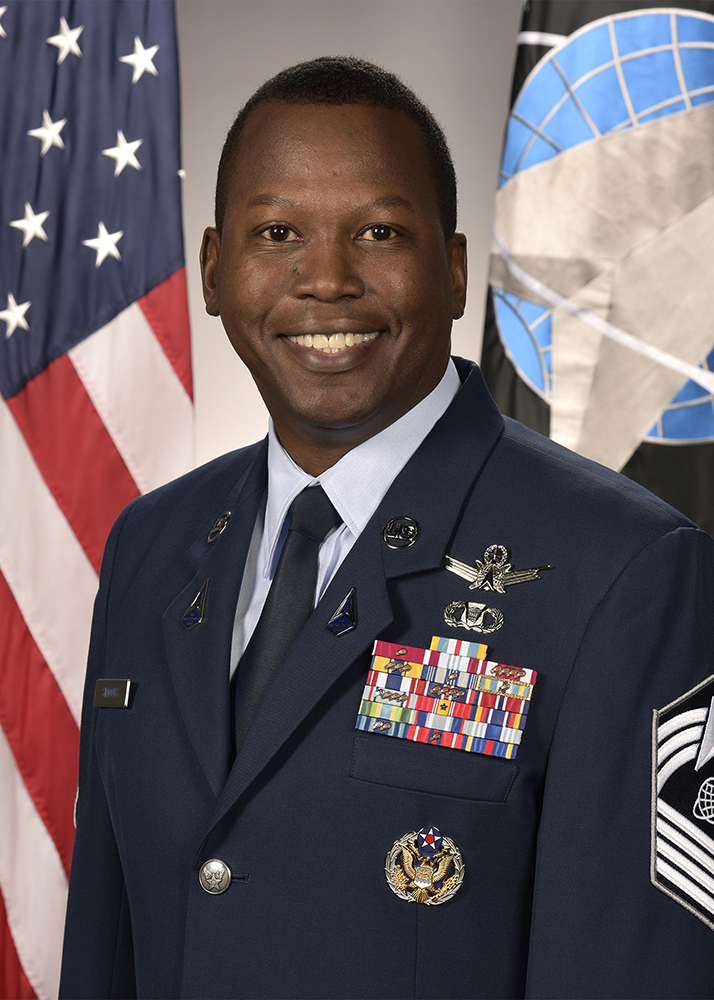Meet the Nominated Space Force Four-Stars
By Chris Gordon
U.S. military space operations are set for a changing of the guard, with Space Force Lt. Gen. Stephen N. Whiting nominated to be the four-star head of U.S. Space Command (SPACECOM) and Lt. Gen. Michael A. Guetlein nominated to be the next Vice Chief of Space Operations.
Both must first be confirmed by the U.S. Senate.
Whiting is currently head of Space Operations Command (SpOC) at Peterson Space Force Base, Colo., the service’s component command to SPACECOM. SpOC is one of three Space Force field commands and supplies forces for communications; command and control; domain awareness; intelligence, surveillance, and reconnaissance; and more.
SPACECOM was established months ahead of the Space Force, in 2019, as a distinct combatant command responsible for military operations beyond 100 kilometers above sea level. The Space Force is responsible for organizing, training, and equipping space forces.
Once confirmed, Whiting will take over SPACECOM from Army Gen. James Dickinson, marking the first time the Space Force has had more than two four-star generals. Meanwhile, Guetlein will succeed Gen. David D. Thompson as the USSF’s second-highest ranking officer. Thompson has been the service’s first and only Vice Chief since the role was created in October 2020.
As head of Space Systems Command (SSC), the Space Force’s acquisition field command headquartered in Los Angeles, Guetlein has been an outspoken proponent of accelerating space technology development and deployment and of focusing on the threat posed by U.S. rivals, particularly China. Prior to taking up command of SSC, Guetlein was deputy director of the National Reconnaissance Office.
Lt. Gen. Philip A. Garrant, currently a member of the Space Staff as deputy chief of space operations for strategy, plans, programs, and requirements, is set to succeed Guetlein at SSC, retaining his current rank.
Thompson is expected to retire. SPACECOM’s deputy commander is also a Guardian, Lt. Gen. John E. Shaw, who assumed that role in 2020.
Whiting and Guetlein’s confirmation to their new roles may take time—they are among 250 general officer nominations currently on hold. Sen. Tommy Tuberville (R-Ala.) placed a blanket hold on all military promotions earlier this year in protest of a Department of Defense policy authorizing the military to pay for out-of-state members and dependents to access reproductive health care, such as abortions and in-vitro fertilization, if those services are not available where they are located.
The Senate could circumvent Tuberville’s hold by holding roll call votes on every nomination individually, but with so many nominations backed up, that is increasingly unlikely.
Meanwhile, the selection of a permanent headquarters for SPACECOM is also in flux. The decision has been bogged down by political squabbling and investigations ever since then-President Trump selected Redstone Arsenal, near Huntsville, Ala., as its future home. Air Force Secretary Frank Kendall has yet to decide whether to finalize the Alabama selection or to keep the command at its temporary home in Colorado Springs, Colo.
SPACECOM’s New Senior Enlisted Leader
Chief Master Sgt. Jacob C. Simmons will succeed Marine Corps Master Gunnery Sgt. Scott H. Stalker as Senior Enlisted Leader at U.S. Space Command, the Pentagon announced.
Currently the senior enlisted leader at Space Operations Command (SpOC), also at Peterson Space Force Base, Colo., Simmons took that role in 2022, following in the footsteps of Chief Master Sgt. John Bentivegna (recently tapped to become the next Chief Master Sergeant of the Space Force) and Chief Master Sgt. of the Space Force Roger A. Towberman, the second-ever Guardian.
“Space is ubiquitous,” Simmons said at AFA’s Air, Space & Cyber Conference in September 2022. “It is involved in every mission, it is involved in every capability, and it must be intertwined as such.”
Simmons was one of the five finalists to replace outgoing Towberman to become the second-ever senior noncommissioned officer in the service’s history.“
I enlisted into the military because I wanted to do something that mattered; something I could be proud doing until I figured out which way was up for my life,” Simmons said in a 2018 interview. “Growing up at Fort Hood, Texas, I actually had every intention of joining the Army and would have been a Soldier had I not listened to a still small voice during one life-changing event,” Simmons said.
“While getting set to sign my very final piece of Army enlistment paperwork at MEPS [Military Entrance Processing Station], an Airman walked by in service dress. I stopped just shy of the oath when I realized that in my eagerness to get life started, I didn’t research all of my options. I owed myself that.”
Study: US Needs Counterspace Weapons for Space Superiority
By Greg Hadley
The Space Force and U.S. Space Command should field counterspace weapons and related capabilities to ensure space superiority in the future, according to a senior Space Force operator and also a new paper from the Mitchell Institute for Aerospace Studies.
Fielding such weapons will require a shift in mindset and major changes in policy, classification, force structure, and personnel, said Maj. Gen. David N. Miller, director of operations, training, and force development for U.S. Space Command.
“I think we’re past the point of, ‘Is space a warfighting domain?’ I think we’re past the point of, ‘Has space been weaponized?’” Miller said June 27 at a rollout event for the new Mitchell Institute paper. He cited China’s demonstration of a fractional orbital bombardment system and Russia’s test of a direct ascent anti-satellite missile.
Retired Col. Charles S. Galbreath, senior resident fellow for space studies at the Mitchell Institute, argues in a new research paper that the U.S. needs its own counterspace capabilities to counter those threats and deter China and Russia from putting such weapons to use.
“Recognizing space as a warfighting domain means any serious effort to achieve space security must include space weapons,” Galbreath wrote. “It’s oxymoronic to establish a new military service charged with protecting interests in space without arming it with the weapons it must have to accomplish its mission.”
SPACECOM Director of Operations, Training, and Force Development Maj. Gen. David MillerStop debating whether it’s a warfighting domain, … whether there are weapons, and get to the point of how do we responsibly … deter conflict.
Space is just like any other warfighting domain, said retired Gen. Kevin P. Chilton, Explorer Chair of the Mitchell Institute’s Spacepower Advantage Center of Excellence. “If you are a Soldier talking about the land domain, a Sailor talking about the maritime domain, or an Airman talking about the air domain, you’d be demanding those capabilities: situational awareness and the ability to find, fix, target, track and if necessary, kill an adversary in their domain.”
Space is no different, he said. But because space was for so long a peaceful, permissive environment and because destructive actions there can create dangerous debris fields that last for decades and threaten every satellite in that orbit, counterspace weapons have long been considered taboo.
Those hurdles continue, Miller said. “There was an almost equating of space superiority with protect and defend,” Miller said. “And we began to see, while that may have been useful in some circles … that ultimately undermined the discussion of where we needed to be in our operating concepts as the service the nation expects to provide space superiority.”
The very fact of China’s and Russia’s counterspace capabilities makes clear the need to “stop debating if it’s a warfighting domain, stop debating whether there are weapons, and get to the point of how do we responsibly, as part of the joint and combined force, deter conflict that nobody wants to see,” Miller added. “But if we do see [conflict, the U.S. must] demonstrate our capability to win as a part of a joint combined team.”
Chief of Space Operations Gen. B. Chance Saltzman has pushed that capability part of his “Competitive Endurance” theory. In particular, Miller highlighted the importance of an expanded intelligence enterprise giving SPACECOM more awareness and information to conduct a full range of operations in space.
“[It’s] making sure we have both the intelligence capability and capacity, as well as the day-to-day surveillance and where needed, the focused reconnaissance capability, to provide precision tracking, custody, and, if necessary, targeting information in order to disrupt space-enabled threats,” Miller said.
Miller called for “a culture of campaigning” that goes beyond posturing and focuses on tailored operations that demonstrate to adversaries that the U.S. is prepared to act. That means not just weapons, but extensive training.
“That’s a pipeline that doesn’t exist right now,” Galbreath noted. “All of the operators, all of the Guardians, need to be aware of what threats are out there and how they might present to the systems they operate or are fielding.”
Investing in test and training infrastructure has been a top priority for Saltzman in his early tenure as CSO, and Miller indicated that the entire service is shifting how it develops personnel through both education, training, and leadership opportunities.
The Space Force will also need help from industry, which will also need to shift its approach to the domain, said Robert Atkin, vice president of special space systems at General Atomics.
“In the beginning, the primary thing that we focused on when building spacecraft was, will it survive launch and will it survive the radiation environment?” Atkin said. “We didn’t pay any attention to the fact that someone may be trying to shoot us down or kill us in some other way. And I think the adversaries have accelerated that, and we have kind of underestimated how fast they were doing that and how fast they were capable of doing that.”
Among the recommendations in his research paper, Galbreath called for the Space Force and industry to work together to develop defensive and offensive capabilities—quickly. He also argued for:
- Clear guidance from senior military and civilian leaders on the need for counterspace weapons;
- A counterspace force design developed by the Space Warfighting Analysis Center;
- Improvements from the Space Force in space situational awareness; telemetry, tracking, and control of satellites; and test and training infrastructure ; and
- Additional funding for the Space Force from Congress.

